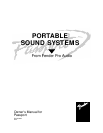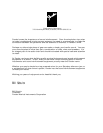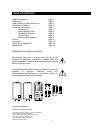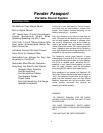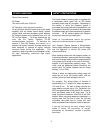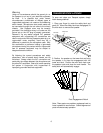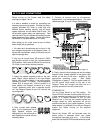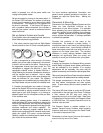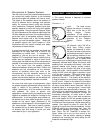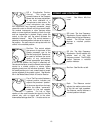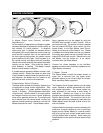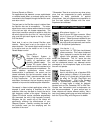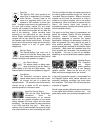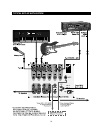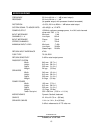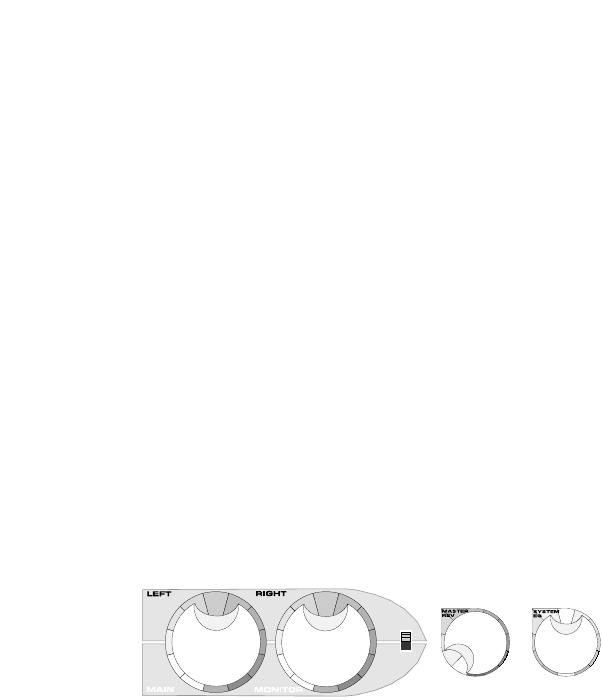
switch is operated, turn off the power switch and
unplug both speaker cables.
Re-set the system by turning on the power switch. If
the Protect LED illuminates, the system is indicating
a short circuit is present on one or more of the cables
or connections. The Passport will not operate until
the short is corrected. If the Protect LED stays on
with no speaker cables connected, this indicates a
fault with your system, consult an authorized service
center technician.
Set-up System Volume and Levels
To set system volume and operating levels, be sure to
follow these simple set-up guidelines:
1. First, slowly raise the large Left and Right Master
volume controls to their 12 o’clock notched positions.
2. Use a microphone (or other source) in the same
position as it will be used on stage and in the manner
in which it will be used for the event. Slowly bring up
the appropriate channel input level control (ie: if the
microphone is plugged into Mic/Line 1 input, the
appropriate channel control is labeled Mic/Line 1
Level), listening for the onset of feedback or howling or
until the required level is reached. Have a helper
“walk” the audience area to make sure coverage and
levels are sufficient for your needs. The system’s
overall volume can be raised simply by rotating the Left
and Right Master volume controls to the desired level.
3. Consider the application and needs of the event
and set the System EQ control as appropriate. This
is best achieved by playing recorded material of the
same type as your show program, or by having an
assistant speak into the microphone while you listen
in the audience area.
For public address (spoken voice), it is advisable to
rotate the System EQ control clockwise to enhance the
mid and high frequencies, and limit the low frequency
content. For large outdoor spaces this will also give the
maximum headroom and output capability. For
sustained low frequency program material (such as
certain musical programs) which demand more power,
rotate the system EQ control counter-clockwise.
Carefully consider the individual event’s needs and set
your control for the maximum effect.
For more technical applications information and
general sound systems operational instruction, we
suggest you read the Fender Book - Making the
Connection.
Placement & Mounting
Placement of the Passport Speaker Systems and the
Tower can have significant influence on the
performance of your sound system. It is advisable
when operating any sound equipment controls that
you are in a position to hear the effect of any changes
made. Speaker systems must be placed with great
care to achieve the best effect. It is always advisable
to elevate the speakers.
Consider the proximity of the users to the
microphones. For example: a person holding a
microphone close to their mouth and talking/singing
even at a medium level, inputs literally hundreds of
times more signal power than one using the mic at a
distance of one meter (three feet). The resultant
difference in control settings between these two
examples will significantly effect the quality and
quantity of sound you will achieve with your system.
Power Tower
™
In setting up the system, the Passport Mixing console
should ideally be placed where system performance
can be evaluated by the operator. If no ongoing
adjustments will be necessary, the mixer may be
placed conveniently and where the cable lengths allow.
Take care to place the Power Tower where the cables will
not trip anyone. All cables should be carefully secured.
The storage compartment in the rear of the Tower
can hold cables, microphones and other system
parts. To open simply slide the catch upwards and
pull open.
The mains (AC) fuse holder is under the IEC (power
cord) socket on the right rear of the Tower. To change
a fuse, remove the IEC plug and, using an
appropriate tool pull out the fuse holder. Note there
is a spare fuse in the fuse holder; the Passport utilizes
a 6.3A 250V fuse. Only replace fuses with one of an
identical value and size.
The Passport System is weather resistant in its
packed- transport mode. However, when operating
outdoors, take care to fully protect the Power Tower
in the event of exposure to rain.
Remember to allow free air flow over the heatsink
area on the top rear of the Tower.
8



